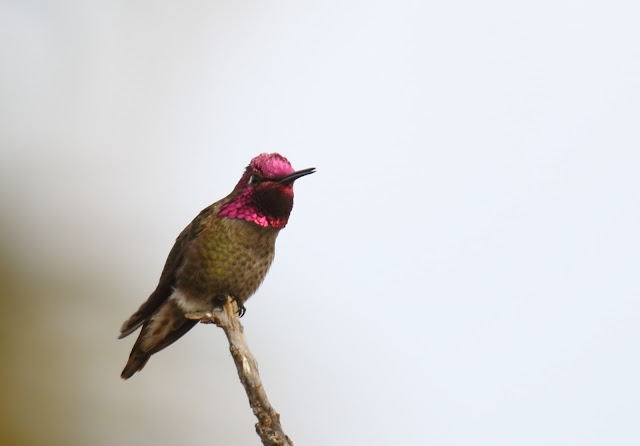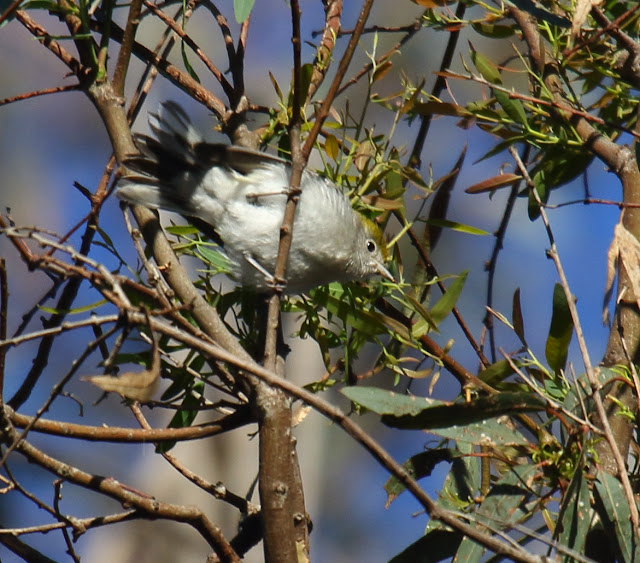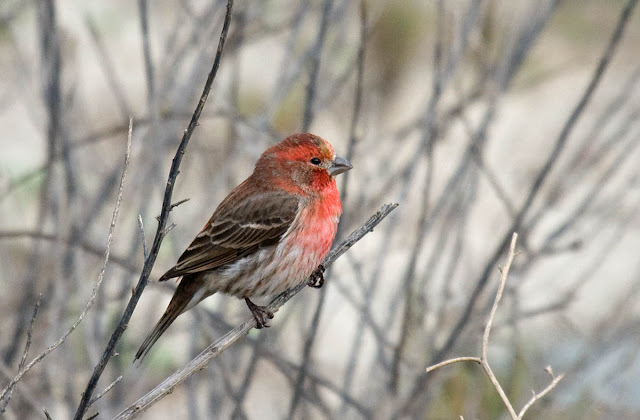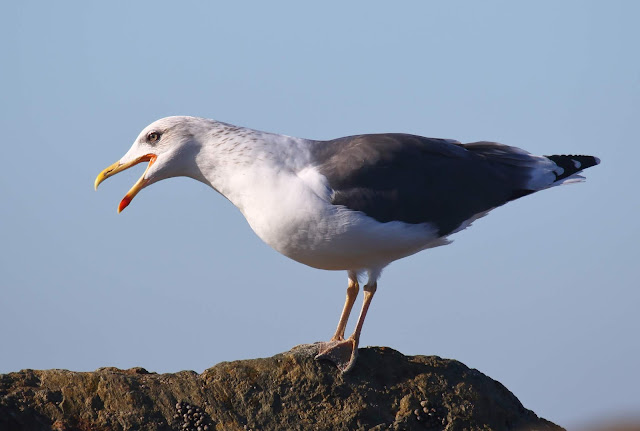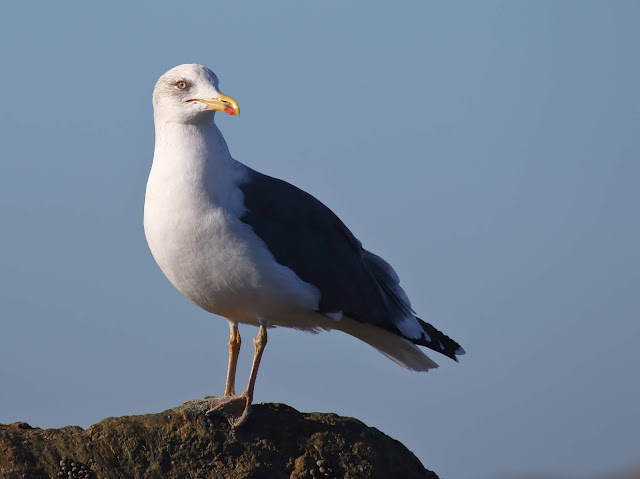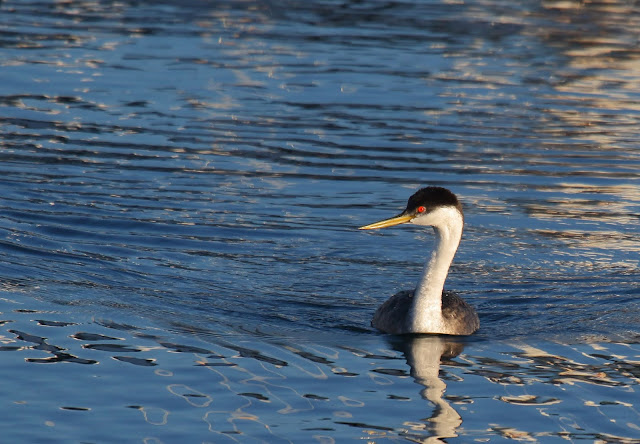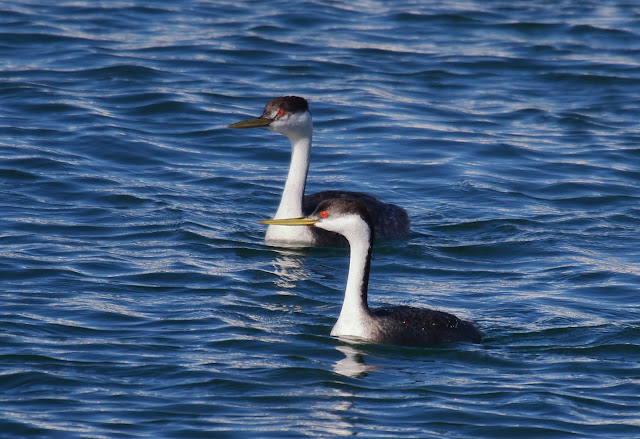 |
| Song Sparrow. Imperial Beach, California. January 20, 2019. |
Thursday, February 28, 2019
Song Sparrow at Imperial Beach
Here is a Song Sparrow at Imperial Beach during my "King Tide" visit. There's really nothing special about the bird or the photo.
More photos of Song Sparrow in San Diego from eBird. Click on the photos to rate (1 awful, 2 poor but identifiable, 3 average or small, 4 very good, 5 magazine cover worthy).
Wednesday, February 27, 2019
White-crowned Sparrow in Imperial Beach
Most of the White-crowned Sparrows in San Diego are the pale-lored* and bright clean plumaged Gambel's form, Zonotrichia leucophrys gambelii. They nest in southwest Canada and southern Alaska and migrate farther south for winter than the Puget Sound White-crowned Sparrows, Z. l. pugetensis (breed in Pacific Northwest and migrate to central California) and the mostly non-migratory Nuttall's White-crowned Sparrow, Z. l. nuttalli (residents in central coastal California).
When more northerly-breeding populations migrate farther south than those breeding in middle latitudes (relatively speaking) this is called "leapfrog" migration. Fox Sparrow populations in western North American also do this.
Some dark-lored Mountain White-crowned Sparrows, Z. l. oriantha, breeding in the interior mountains of the western United States. A few of these sometimes reach southern California in winter.
* Lores (usually used as a plural) are the feathers in the region of the face directly between the eye and bill.
More photos of White-crowned Sparrows in San Diego from eBird. Click on the photos to rate (1 awful, 2 poor but identifiable, 3 average or small, 4 very good, 5 magazine cover worthy).
When more northerly-breeding populations migrate farther south than those breeding in middle latitudes (relatively speaking) this is called "leapfrog" migration. Fox Sparrow populations in western North American also do this.
 |
The pale lores and orangish bill help identify the Gambel's White-crowned Sparrow.
In laurel sumac bush. Imperial Beach, California. January 20, 2019. Greg Gillson.
|
* Lores (usually used as a plural) are the feathers in the region of the face directly between the eye and bill.
More photos of White-crowned Sparrows in San Diego from eBird. Click on the photos to rate (1 awful, 2 poor but identifiable, 3 average or small, 4 very good, 5 magazine cover worthy).
Tuesday, February 26, 2019
Savannah Sparrow at Imperial Beach
Migrant Savannah Sparrows winter in coastal wetlands. The darker Belding's form photographed here is a local resident in salt marshes of southern California.
eBird photos of Savannah Sparrow in San Diego. Click on the photos to rate (1 awful, 2 poor but identifiable, 3 average or small, 4 very good, 5 magazine cover worthy).
 |
| Belding's Savannah Sparrow. Imperial Beach, California. January 20, 2019. Greg Gillson. |
Monday, February 25, 2019
Anna's Hummingbirds in Imperial Beach
Hummingbirds are very photogenic. But it is also easy to get lots of bad ("not magazine cover quality") images.
The photos I got this day were not too bad, but no magazine covers.
More eBird photos of Anna's Hummingbirds in San Diego County. Click on the photos to rate (1 awful, 2 poor but identifiable, 3 average or small, 4 very good, 5 magazine cover worthy).
The photos I got this day were not too bad, but no magazine covers.
 |
| Anna's Hummingbird. Imperial Beach, California. January 20, 2019. Greg Gillson. |
Sunday, February 24, 2019
Rare bird: Chestnut-sided Warbler in "lerpy euc"
On November 23, 2018, Nancy Christensen located a Chestnut-sided Warbler at Batiquitos Lagoon. These birds breed in scrubby forests in eastern North America.
eBird told me I saw 3 birds in a visit to New York in May 1982 and vagrants twice in Oregon in May 1999 and July 2003. As "Nancy's bird" stuck around for more than a month, and was not too far from my home, I decided to go look for it one sunny morning before work.
I spent about a half hour watching many NON-Chestnut-sided Warblers chase insects in the first rays of sun on the eastern edge of the specified grove of trees. It was frosty in the shade, but with my back grabbing the sun's meager warmth it was tolerable. Then I encountered Stevan Brad also looking for the bird. After another half hour I spotted the target bird inside the grove rather than on the sunny edge. I called Stevan over and we both got great looks and some workable photographs.
This is probably a first-year female, totally lacking its namesake chestnut sides. The lime green crown, thin white eye ring, and two ample wing bars clinch the ID, though.
What is a "Lerpy Eucalyptus"? I had encountered this term numerous time on the San Diego bird listserv, but nowhere else. Nancy's description of the location of this bird was that it was in a "grove of lerpy euc." However, no Google search turned up any helpful information. In fact, if you search today for "lerpy eucalyptus" it changes your first search term from lerpy to Leroy!
Lerpy eucalyptus refers to a eucalyptus tree infested with lerps. Lerps, according to a very unhelpful Wikipedia entry, are a crystalized honeydew produced by the larvae of psyllid bugs as a protective cover. Interpretation: See those white bumps on the leaves in the above two photos? Yes, I think those are the infamous lerps!
[As I put the final edits on this post I note this term is described in an upcoming new book by the Natural History Museum of Los Angeles County, Gregory B. Pauly et al., called Wild L.A. (March 2019 publication date). Quoting from this book that doesn't exist yet: "In nature, a lerp is the sugary protective covering produced by larvae of psyllid bugs. These bugs are commonly known as lerp insects, and when they infest a tree, birds like warblers swarm in to feast. Birders love to find lerpy eucs (eucalyptus trees)--that's where the birds are."]
There have been 3-6 Chestnut-sided Warblers reported in San Diego County on average over the past few years, primarily during the fall migration, September to October. Thus it was very obliging of this bird to remain for the winter.
More photos of Chestnut-sided Warblers in San Diego from eBird. Click on the photos to rate (1 awful, 2 poor but identifiable, 3 average or small, 4 very good, 5 magazine cover worthy).
eBird told me I saw 3 birds in a visit to New York in May 1982 and vagrants twice in Oregon in May 1999 and July 2003. As "Nancy's bird" stuck around for more than a month, and was not too far from my home, I decided to go look for it one sunny morning before work.
I spent about a half hour watching many NON-Chestnut-sided Warblers chase insects in the first rays of sun on the eastern edge of the specified grove of trees. It was frosty in the shade, but with my back grabbing the sun's meager warmth it was tolerable. Then I encountered Stevan Brad also looking for the bird. After another half hour I spotted the target bird inside the grove rather than on the sunny edge. I called Stevan over and we both got great looks and some workable photographs.
This is probably a first-year female, totally lacking its namesake chestnut sides. The lime green crown, thin white eye ring, and two ample wing bars clinch the ID, though.
 |
| Chestnut-sided Warbler, Carlsbad, California. January 4, 2019. |
What is a "Lerpy Eucalyptus"? I had encountered this term numerous time on the San Diego bird listserv, but nowhere else. Nancy's description of the location of this bird was that it was in a "grove of lerpy euc." However, no Google search turned up any helpful information. In fact, if you search today for "lerpy eucalyptus" it changes your first search term from lerpy to Leroy!
Lerpy eucalyptus refers to a eucalyptus tree infested with lerps. Lerps, according to a very unhelpful Wikipedia entry, are a crystalized honeydew produced by the larvae of psyllid bugs as a protective cover. Interpretation: See those white bumps on the leaves in the above two photos? Yes, I think those are the infamous lerps!
[As I put the final edits on this post I note this term is described in an upcoming new book by the Natural History Museum of Los Angeles County, Gregory B. Pauly et al., called Wild L.A. (March 2019 publication date). Quoting from this book that doesn't exist yet: "In nature, a lerp is the sugary protective covering produced by larvae of psyllid bugs. These bugs are commonly known as lerp insects, and when they infest a tree, birds like warblers swarm in to feast. Birders love to find lerpy eucs (eucalyptus trees)--that's where the birds are."]
There have been 3-6 Chestnut-sided Warblers reported in San Diego County on average over the past few years, primarily during the fall migration, September to October. Thus it was very obliging of this bird to remain for the winter.
More photos of Chestnut-sided Warblers in San Diego from eBird. Click on the photos to rate (1 awful, 2 poor but identifiable, 3 average or small, 4 very good, 5 magazine cover worthy).
Saturday, February 23, 2019
Northern Mockingbird in bougainvillea
Well, this had the potential to be an excellent photo, but I just couldn't get the angle to get stray branches out of the way. Still, it has pleasant golden morning light and some pretty contrasting flowers.
Here are some more photos of Northern Mockingbirds in San Diego from eBird. Click on the photos to rate (1 awful, 2 poor but identifiable, 3 average or small, 4 very good, 5 magazine cover worthy).
 |
| Northern Mockingbird in bougainvillea. Carlsbad, California. January 4, 2019. |
Friday, February 22, 2019
Black Phoebe at Batiquitos Lagoon
Always photogenic, this phoebe chose to chase insects on a detritus-covered hillside. It was a chilly morning, so the ground here probably warmed faster than the surrounding area and led to the insect activity and happy phoebe breakfast.
More photos of Black Phoebes in San Diego from eBird. Click on the photos to rate (1 awful, 2 poor but identifiable, 3 average or small, 4 very good, 5 magazine cover worthy).
 |
| Black Phoebe. Carlsbad, California. January 4, 2019. |
Thursday, February 21, 2019
Two different American Kestrel photos
I was able to photograph two kestrels in January.
The first in Carlsbad was a bit distant, so I only shot a short burst. It turned out well for the distance.
For some reason I couldn't get sharp focus on the bird at Imperial Beach against the busy background. I was within 60 feet. I adjusted shutter speed between 1/400 and 1/2000 second. I concentrated on holding steady. I ended up taking over 100 shots, but just couldn't get it to focus sharply. Only one seemed good enough. I present it below. Fortunately, the bird was hunting fence lizards on an old piling and remained for over 10 minutes. That's why it was so frustrating that I couldn't obtain focus.
More photos of American Kestrels in San Diego from eBird. Click on the photos to rate (1 awful, 2 poor but identifiable, 3 average or small, 4 very good, 5 magazine cover worthy).
The first in Carlsbad was a bit distant, so I only shot a short burst. It turned out well for the distance.
For some reason I couldn't get sharp focus on the bird at Imperial Beach against the busy background. I was within 60 feet. I adjusted shutter speed between 1/400 and 1/2000 second. I concentrated on holding steady. I ended up taking over 100 shots, but just couldn't get it to focus sharply. Only one seemed good enough. I present it below. Fortunately, the bird was hunting fence lizards on an old piling and remained for over 10 minutes. That's why it was so frustrating that I couldn't obtain focus.
 |
| American Kestrel. Carlsbad, California. January 4, 2019. f/5.6 1/800 sec. ISO-100 |
 |
| American Kestrel. Imperial Beach, California. January 20, 2019. f/7.1 1/1000 sec. ISO-800 |
Wednesday, February 20, 2019
Black Turnstone at Coronado
I was able to get close photos of Black Turnstones at Coronado in late December. There aren't too many locations on the San Diego coastline where you can get down to turnstone level. Usually you have to shoot from high above.
Follow the link for eBird photos of Black Turnstones in San Diego County. Click on the photos to rate (1 awful, 2 poor but identifiable, 3 average or small, 4 very good, 5 magazine cover worthy).
 |
| Black Turnstone. Coronado, California. December 30, 2018. Greg Gillson. |
Follow the link for eBird photos of Black Turnstones in San Diego County. Click on the photos to rate (1 awful, 2 poor but identifiable, 3 average or small, 4 very good, 5 magazine cover worthy).
Tuesday, February 19, 2019
Colored pencil art: Yellow-rumped Warbler on succulent
In December I photographed a Yellow-rumped Warbler on a succulent at Silver Strand that I thought would make a great colored pencil drawing.
I'm still working on my photorealism technique. This one is getting closer! I think it needs a bit more fine details, though. My plant drawing actually has more detail than what was visible in the reference photo (see below). In order to be realistic I have to get the proportions perfect. Unfortunately, I think I made the warbler's bill a touch too big and the eye a touch too small. That's something that you can't fix after you've started with the color.
Each drawing is just practice for the next one, or so I've been told.
I'm still working on my photorealism technique. This one is getting closer! I think it needs a bit more fine details, though. My plant drawing actually has more detail than what was visible in the reference photo (see below). In order to be realistic I have to get the proportions perfect. Unfortunately, I think I made the warbler's bill a touch too big and the eye a touch too small. That's something that you can't fix after you've started with the color.
Each drawing is just practice for the next one, or so I've been told.
 |
| Yellow-rumped Warbler on succulent. Prismacolor colored pencil. 2019. Greg Gillson |
 |
| Putting in the background. |
 |
| The flower stalk: first of many layers. |
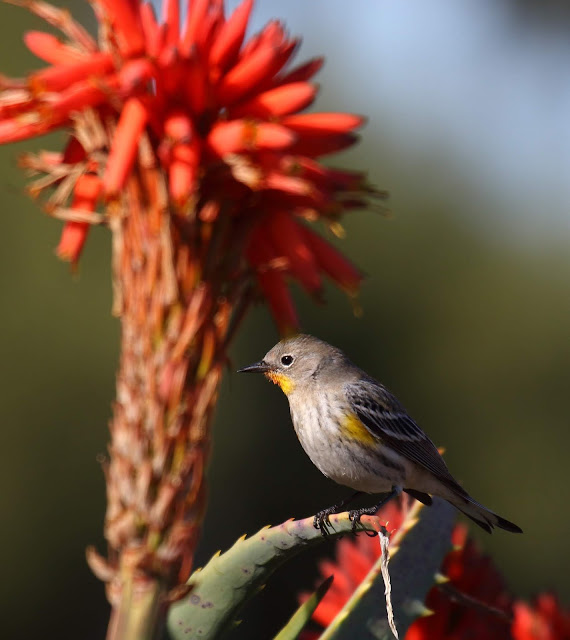 |
| My reference photo. |
Monday, February 18, 2019
The 10 most common backyard birds of San Diego, California
The following 10 species of backyard birds are the most frequent in the San Diego region. In fact, these 10 would be common backyard birds nearly anywhere in California away from mountains and driest deserts. From Redding south to Bakersfield, and San Francisco south to San Diego, it might be difficult to find a residential backyard where all these birds do not occur, year-round.
These birds, then, would certainly serve as an introduction to backyard bird watching in California.
Can you spot these 10 in your backyard? Which one is your favorite?
1) Lesser Goldfinch
The tiny Lesser Goldfinches like weedy fields with oak savannas where they eat small seeds. To attract them to your yard, hang up a "thistle sock" stocked with Nyjer seed.
2) House Finch
House Finches are found in residential areas and farms with scattered trees. To attract them to your yard put up a tube feeder with black oil sunflower seeds.
3) Mourning Dove
Mourning Doves are birds of open residential and farmlands. To attract them to your yard feed sunflowers, cracked corn on a tray feeder. They nest in covered corners--carport beams, on porch lights, etc. Listen for their mournful crying song (boo, hoo-hoo) on spring mornings.
4) Anna's Hummingbird
These pugnacious little sprites love flowering plants and small insects. To attract them to your yard plant flowers and hang a hummingbird feeder with 4 parts water to 1 part table sugar. They nest very early, late December to March).
5) Northern Mockingbird
Mockingbirds hang out in residential areas with large dense shrubs. They eat insects and berries. They'll sing from telephone lines and low trees, nearly non-stop, day-and-night, all year long.
6) California Scrub-Jay
Jays are bold and brash and eat animals and vegetables as food. Because they are large and take lots of food away from the feeder to hide it for later (called caching), you may not want too many Scrub-Jays in your backyard. If you have an older field guide you may find this bird listed as Western Scrub-Jay.
7) American Crow
Frequently found in cities, crows are smart enough to get into nearly any kind of trash container to find human food scraps. In residential areas they may only visit during the day, flying off at dusk to roost in the hundreds in orchards or other dense patch of trees. They frequently gang up on hawks and owls, making a noisy mob.
8) Black Phoebe
Frequenting quiet ponds and wet places, large expanses of grass lawns make a great substitute for this flycatcher that feeds on low-flying insect. Their sweet chip note, bobbing tail, and unfearing nature makes them a favorite backyard bird.
9) California Towhee
This large sparrow is rather plain brown. It will feed on sunflower seeds on a tray feeder or, more likely, on the ground under it. They hide under bushes in residential areas, kicking leaves with both feet to see what's under them. When they do this in your feeder they can scatter seed everywhere!
10) Western Bluebird
While they might be more abundant in an open oak woodland, Western Bluebirds don't mind putting up with residential human activities if there is an expanse of lawn or pasture they can search nearby for bugs. They also need a gnarled tree with a cavity to use as a nest. Placing a nest box on your property may make it more enticing, if there is ample lawn nearby.
Want more? Here are Another 10 common backyard birds of San Diego.
And... A Final 10 common backyard birds of San Diego.
These birds, then, would certainly serve as an introduction to backyard bird watching in California.
Can you spot these 10 in your backyard? Which one is your favorite?
1) Lesser Goldfinch
 |
| Male Lesser Goldfinch. Fallbrook, California. May 4, 2014. |
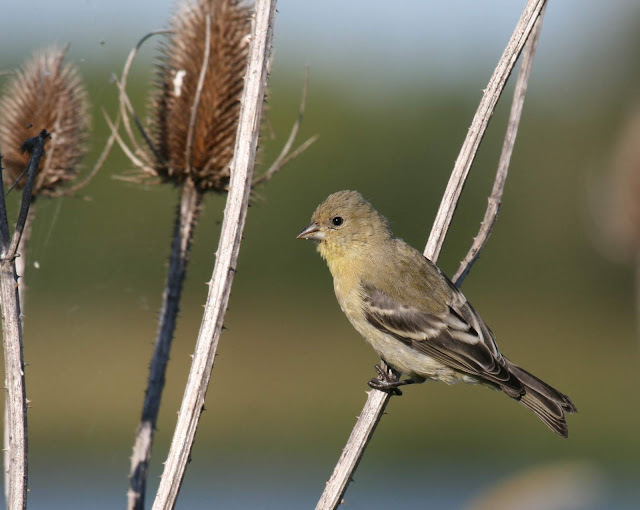 |
| Female Lesser Goldfinch. Forest Grove, Oregon. August 28, 2007. |
2) House Finch
| Male House Finch. Imperial Beach, California. January 30, 2016. |
 |
| Female House Finch. Escondido, California. June 20, 2018. |
3) Mourning Dove
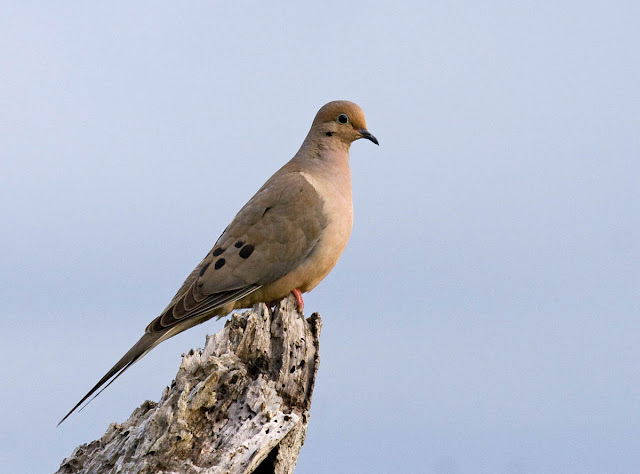 |
| Mourning Dove. Solana Beach, California. May 17, 2017. |
4) Anna's Hummingbird
 |
| Male Anna's Hummingbird. Rancho Bernardo, California. January 21, 2018. |
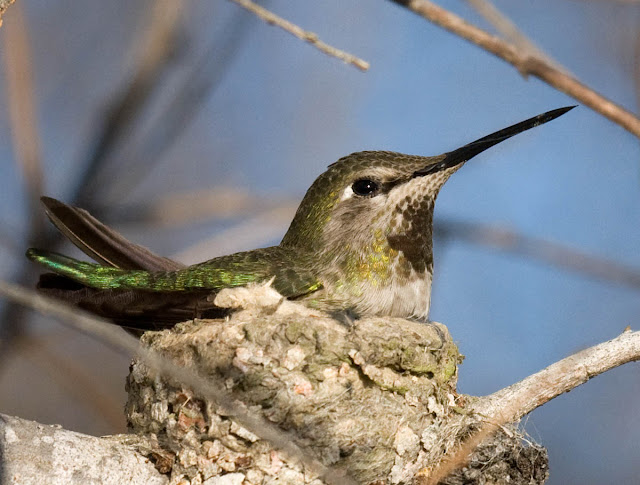 |
| Female Anna's Hummingbird on nest. Cardiff, California. February 1, 2016. |
5) Northern Mockingbird
 |
| Northern Mockingbird. Borrego Springs, California. January 7, 2018. |
6) California Scrub-Jay
 |
| California Scrub-Jay. Hillsboro, Oregon. April 21, 2010. |
7) American Crow
 |
| American Crow. Newport, Oregon. April 20, 2008. |
8) Black Phoebe
 |
| Black Phoebe. San Diego, California. May 10, 2015. |
9) California Towhee
 |
| California Towhee. Poway, California. April 8, 2018. |
10) Western Bluebird
 |
| Male Western Bluebird. Beaverton, Oregon. March 9, 2013. |
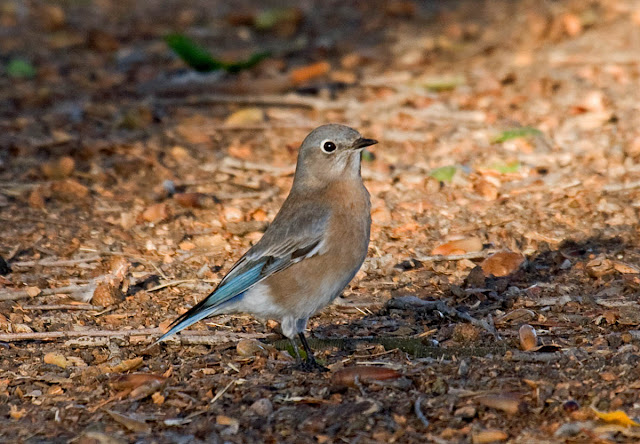 |
| Female Western Bluebird. Santee, California. October 11, 2013. |
Want more? Here are Another 10 common backyard birds of San Diego.
And... A Final 10 common backyard birds of San Diego.
Sunday, February 17, 2019
Fieldcraft: How to use and improve eBird Media Search bird photos
You may have noticed when I present some of my recent bird photos that I provide a link to eBird photos. You may just enjoy looking at bird photos, but these photos can help you improve as a birder. I also encourage rating those photos. Here is the why and how.
Why use eBird Media Search Tool?
eBird Media Search is an indispensable tool to help learn what local birds look like. What do I mean--what's wrong with a field guide?
The immediate example that comes to mind is a rare seabird to the West Coast of North America--Short-tailed Albatross. If you look at Sibley or the National Geographic guide, what do you see? In the recent versions (Editions 2 and 7, respectively), 5 or more illustrations of a giant white-and-black bird with golden head and big white wing patches (in older field guide versions only 1-2 illustrations of the adult, or just the head). However, the only place in North America you are likely to see this bird with any white on it at all is the Aleutians on special birding cruises. Only juvenile and birds less than 2 years old are found south of Alaska--all dark chocolatey brown. Take a look at the eBird photos from Oregon: here.
For a more recent example, there was a Chestnut-sided Warbler reported wintering not far from my home. What does it look like? Well, it happens to be a first-year female. It doesn't even have chestnut sides! But it does have a nice lime green crown and white eye ring. I knew exactly what to look for (now and in the future). See photos here.
Choose your location (or intended location, if planning a trip) and choose the month you will be there. See what the birds looks like at that time of year! If it is far away, you may not even recognize the common local Song Sparrows from that region!
How do you view the Media Search Tool?
Start at the eBird home page (www.ebird.org). Choose the Explore tab. Scroll down to the Search Photos and Sound link. This brings you to the eBird Media catalog of Macaulay Library. Ooh, 10 million bird photos... and growing!
We need to filter this.
1) First limit the location, say, to a county, perhaps San Diego, California (United States). You can limit it to as small as an eBird Hotspot or as large as the world.
2) Change the View Results icons from Gallery (default) to Grid. Now you can see the 5-star rating of each photo and other details.
3) Reorder the photos. There is a filter for Recently Uploaded (default), Best Quality, Least Rated, oldest, and newest. These reorder the photos in useful ways that I'll explain in a moment.
What do the Photo Ratings mean?
There is a 5-star rating system for the photos. eBird has a help file, but I tend to remember it this way:
1) Awful. There's a bird in that photo?
2) Poor photo (tiny, out-of-focus, more than half hidden)
3) Average point-and-shoot type photo, small in frame, slightly out-of-focus or partially hidden in foliage.
4) Very good, but not perfect. Often the bird is large and sharp, perhaps blocked by a small stick or cast with a harsh shadow, or the background is distracting.
5) Magazine cover quality. Sharply focused. Eye level. Frame-filling. Looking at the camera. No distracting shadows. Pleasantly blurred or non-distracting background.
Most of the photos in eBird are 3s and 4s. The only time anyone should put in a 1 is for documentation of a rare species. Okay, eBird tracks your photo list as it does your sightings list. Some people may enter a 2 for their first photo of a species, but shouldn't put in bunches of 1s and 2s. But that's my opinion, not an eBird rule. Photographers always try for a 5, but that quality rarely happens without planning your photoshoot in advance.
How are the Photo Ratings used?
eBird uses the better-rated photos in illustrated checklists at a local, county, country, or world level. And you can sort the photos by "best rated" first for your general viewing pleasure.
What happens in practice?
1) No rating.
2) "Improper" rating.
Some photographers do not rate (any or some of) their personal photos. Or they may not rate their poorer photos. Others might tend to rate poorer photos as better than they are, especially if the bird is rare or charismatic and colorful.
So, then, one of two things happens. A great photo is not shown because no one rated it. A poorer photo is shown as "Best" when it clearly is not, and then is served up by eBird in illustrated checklists instead of an actually better photo. These are not important in the big scheme of things, I know. But I really like eBird and want it to be the best it can be.
How can you improve the eBird Photo Rating?
The more people that rate a photo, the better the result. Here's what I do when looking at eBird photos in media search.
1) I reorder the photos to "Best Quality." Then I rate the first dozen or so that may already be marked as 5 stars, asking: "Is this magazine cover quality?" If not, I give a lower rating, as appropriate, so the best rise to the top.
2) I reorder the photos to "Least Rated." Many of these aren't rated at all. I may "pick and choose" looking for treasures--a top photo with no ratings yet. That starts them up the listing to where they deserve. But it is important that all photos in eBird are rated because they are really in the Macaulay Library--like a museum collection of photographs. Who knows where they may be displayed someday.
Note: You may also come across a misidentified photo. You can report those in the Media Search tool. I just found a good photo of Townsend's Solitaire accidentally added as a Townsend's Warbler--an easy mistake to make! So that's another way you can improve the data... catch mistakes.
Why use eBird Media Search Tool?
eBird Media Search is an indispensable tool to help learn what local birds look like. What do I mean--what's wrong with a field guide?
The immediate example that comes to mind is a rare seabird to the West Coast of North America--Short-tailed Albatross. If you look at Sibley or the National Geographic guide, what do you see? In the recent versions (Editions 2 and 7, respectively), 5 or more illustrations of a giant white-and-black bird with golden head and big white wing patches (in older field guide versions only 1-2 illustrations of the adult, or just the head). However, the only place in North America you are likely to see this bird with any white on it at all is the Aleutians on special birding cruises. Only juvenile and birds less than 2 years old are found south of Alaska--all dark chocolatey brown. Take a look at the eBird photos from Oregon: here.
For a more recent example, there was a Chestnut-sided Warbler reported wintering not far from my home. What does it look like? Well, it happens to be a first-year female. It doesn't even have chestnut sides! But it does have a nice lime green crown and white eye ring. I knew exactly what to look for (now and in the future). See photos here.
Choose your location (or intended location, if planning a trip) and choose the month you will be there. See what the birds looks like at that time of year! If it is far away, you may not even recognize the common local Song Sparrows from that region!
How do you view the Media Search Tool?
Start at the eBird home page (www.ebird.org). Choose the Explore tab. Scroll down to the Search Photos and Sound link. This brings you to the eBird Media catalog of Macaulay Library. Ooh, 10 million bird photos... and growing!
We need to filter this.
1) First limit the location, say, to a county, perhaps San Diego, California (United States). You can limit it to as small as an eBird Hotspot or as large as the world.
2) Change the View Results icons from Gallery (default) to Grid. Now you can see the 5-star rating of each photo and other details.
3) Reorder the photos. There is a filter for Recently Uploaded (default), Best Quality, Least Rated, oldest, and newest. These reorder the photos in useful ways that I'll explain in a moment.
 |
| The world's highest rated photos in eBird. They're nice, but are they really the best? Over 200 ratings! |
What do the Photo Ratings mean?
There is a 5-star rating system for the photos. eBird has a help file, but I tend to remember it this way:
1) Awful. There's a bird in that photo?
2) Poor photo (tiny, out-of-focus, more than half hidden)
3) Average point-and-shoot type photo, small in frame, slightly out-of-focus or partially hidden in foliage.
4) Very good, but not perfect. Often the bird is large and sharp, perhaps blocked by a small stick or cast with a harsh shadow, or the background is distracting.
5) Magazine cover quality. Sharply focused. Eye level. Frame-filling. Looking at the camera. No distracting shadows. Pleasantly blurred or non-distracting background.
Most of the photos in eBird are 3s and 4s. The only time anyone should put in a 1 is for documentation of a rare species. Okay, eBird tracks your photo list as it does your sightings list. Some people may enter a 2 for their first photo of a species, but shouldn't put in bunches of 1s and 2s. But that's my opinion, not an eBird rule. Photographers always try for a 5, but that quality rarely happens without planning your photoshoot in advance.
How are the Photo Ratings used?
eBird uses the better-rated photos in illustrated checklists at a local, county, country, or world level. And you can sort the photos by "best rated" first for your general viewing pleasure.
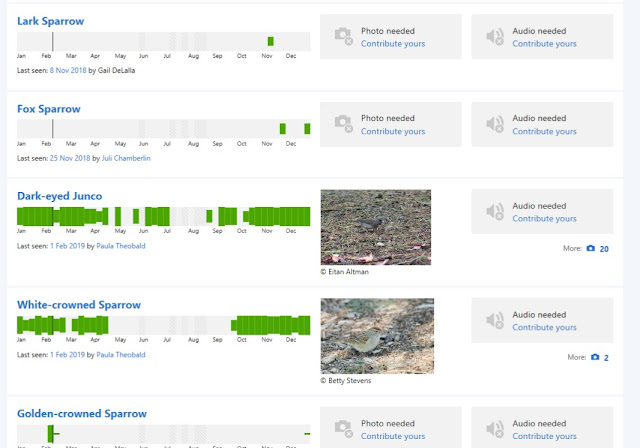 |
| Sample eBird Illustrated Checklist at Buddy Todd Park, Oceanside, California. More photos needed! |
What happens in practice?
1) No rating.
2) "Improper" rating.
Some photographers do not rate (any or some of) their personal photos. Or they may not rate their poorer photos. Others might tend to rate poorer photos as better than they are, especially if the bird is rare or charismatic and colorful.
So, then, one of two things happens. A great photo is not shown because no one rated it. A poorer photo is shown as "Best" when it clearly is not, and then is served up by eBird in illustrated checklists instead of an actually better photo. These are not important in the big scheme of things, I know. But I really like eBird and want it to be the best it can be.
How can you improve the eBird Photo Rating?
The more people that rate a photo, the better the result. Here's what I do when looking at eBird photos in media search.
1) I reorder the photos to "Best Quality." Then I rate the first dozen or so that may already be marked as 5 stars, asking: "Is this magazine cover quality?" If not, I give a lower rating, as appropriate, so the best rise to the top.
2) I reorder the photos to "Least Rated." Many of these aren't rated at all. I may "pick and choose" looking for treasures--a top photo with no ratings yet. That starts them up the listing to where they deserve. But it is important that all photos in eBird are rated because they are really in the Macaulay Library--like a museum collection of photographs. Who knows where they may be displayed someday.
Note: You may also come across a misidentified photo. You can report those in the Media Search tool. I just found a good photo of Townsend's Solitaire accidentally added as a Townsend's Warbler--an easy mistake to make! So that's another way you can improve the data... catch mistakes.
Ring-billed Gull in Coronado
 |
| Ring-billed Gull. Coronado, California. December 30, 2018. Greg Gillson. |
See additional photos of Ring-billed Gulls in San Diego as posted to eBird. Click on the photos to rate (1 awful, 2 poor but identifiable, 3 average or small, 4 very good, 5 magazine cover worthy).
Saturday, February 16, 2019
Rare Lesser Black-backed Gull at Coronado
The beach at the historic Hotel del Coronado was the picturesque site of a rare bird this winter. Ron and Shawn Miller of Wisconsin discovered a Lesser Black-backed Gull there on November 23, 2018.
The identification of this gull is straight-forward, but it will be unfamiliar to most West Coast birders. Large with a dark mantle it has a white eye and yellow legs. Western Gulls have pink legs and often pale grayish or brown eyes. California Gulls are slightly smaller but always have dark brown eyes.
The Miller's didn't identify it immediately; it was "discovered" a few days later, apparently after they posted photos of it on iNaturalist. Fortunately for local birders, the bird was settled in for the winter and will probably remain until early April.
This species breeds on the Atlantic coasts of Europe. It winters south to West Africa. In the last third of the 20th century it underwent a range expansion. It now shows up regularly in eastern North America (southern Atlantic Canada and Great Lakes southward through the Mississippi River Valley), but especially right on the Atlantic coast.
It is more or less annual in San Diego county, now. It wasn't reported in 2010 or 2013, but has averaged about 3 birds per winter since then.
Being the big chaser of rarities that I am (NOT), I didn't make plans to go see it until it had been present over a month. But as you can see, my sloth mattered not. I'm an unenthusiastic chaser, even though I love to find rare birds on my own. Yes, even this life bird.
Photos of this and other Lesser Black-backed Gulls in San Diego on eBird. Click on the photos to rate (1 awful, 2 poor but identifiable, 3 average or small, 4 very good, 5 magazine cover worthy).
 |
| Lesser Black-backed Gull. Coronado, California. December 30, 2018. Greg Gillson. |
The identification of this gull is straight-forward, but it will be unfamiliar to most West Coast birders. Large with a dark mantle it has a white eye and yellow legs. Western Gulls have pink legs and often pale grayish or brown eyes. California Gulls are slightly smaller but always have dark brown eyes.
The Miller's didn't identify it immediately; it was "discovered" a few days later, apparently after they posted photos of it on iNaturalist. Fortunately for local birders, the bird was settled in for the winter and will probably remain until early April.
This species breeds on the Atlantic coasts of Europe. It winters south to West Africa. In the last third of the 20th century it underwent a range expansion. It now shows up regularly in eastern North America (southern Atlantic Canada and Great Lakes southward through the Mississippi River Valley), but especially right on the Atlantic coast.
It is more or less annual in San Diego county, now. It wasn't reported in 2010 or 2013, but has averaged about 3 birds per winter since then.
Being the big chaser of rarities that I am (NOT), I didn't make plans to go see it until it had been present over a month. But as you can see, my sloth mattered not. I'm an unenthusiastic chaser, even though I love to find rare birds on my own. Yes, even this life bird.
 |
View of Point Loma and the mouth of San Diego Bay from Coronado.
The Lesser Black-backed Gull is on the rocks dead center of the photo,
while a Heermann's Gull and Brown Pelican fly past.
|
Friday, February 15, 2019
Heermann's Gull at Coronado
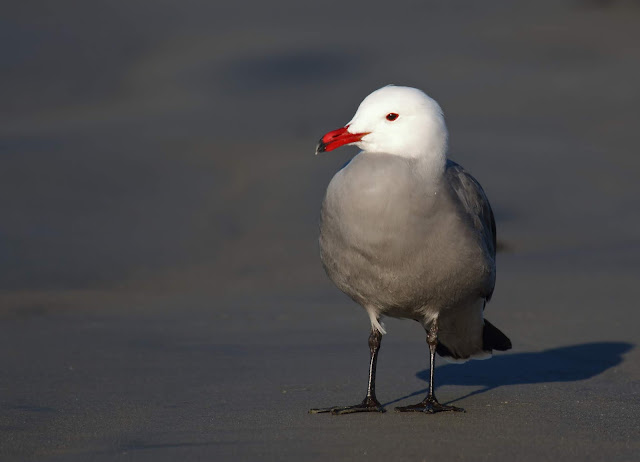 |
| Heermann's Gull. Coronado, California. December 30, 2018. Greg Gillson. |
I'm not the only one to get great shots of Heermann's Gulls in San Diego, check out the eBird photos. Click on the photos to rate (1 awful, 2 poor but identifiable, 3 average or small, 4 very good, 5 magazine cover worthy).
Thursday, February 14, 2019
Western Grebes in San Diego Bay
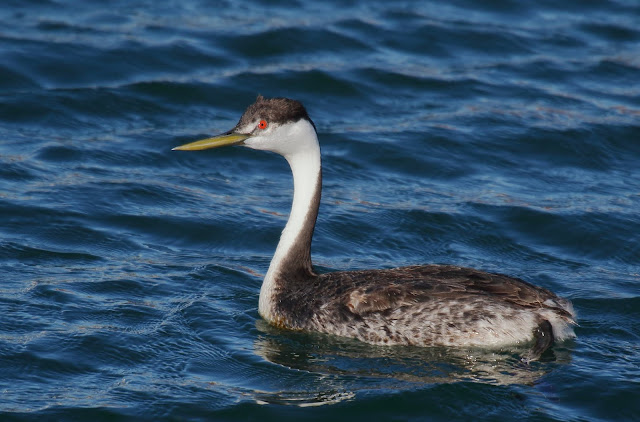 |
| Western Grebe, San Diego Bay. January 1, 2019. Greg Gillson. |
Western Grebes are common wintering birds on large lakes, bays, and nearshore ocean waters. They also breed on large inland lakes. Western Grebes are more numerous than Clark's Grebes, in the same locales and seasonality, but Clark's seem to me to be more numerous on fresh water lakes as opposed to ocean, at least in my experience both in Oregon and southern California.
Follow this eBird link to other photos of Western Grebes in San Diego ordered by highest quality. Click on the photos to rate (1 awful, 2 poor but identifiable, 3 average or small, 4 very good, 5 magazine cover worthy).
Subscribe to:
Comments (Atom)

